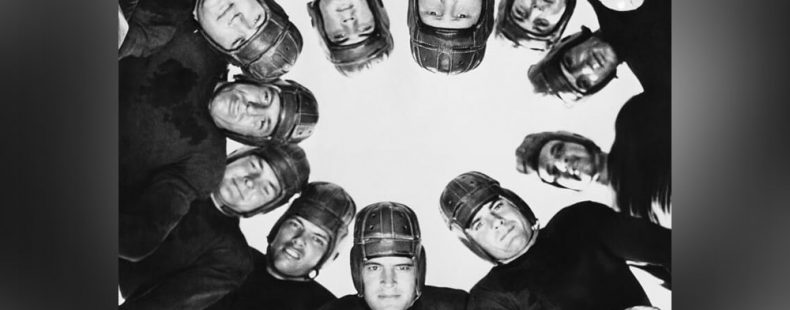With the Super Bowl coming up this Sunday, it’s a good time to take a look at the language of the sport of professional football. Whether you’re referring to words used for penalties such as offside and clipping or actual play calling (which is truly arcane), football has a language all its own. With that in mind, here’s a list of curious football terminology. On three, ready? One-two-three, BREAK!
Fall Into The Gap
It was a catchy slogan for a clothing retailer in the 70s, but in football, a gap is the space between offensive linemen. Each gap is given a letter. The gap between the center and the guard is the “A” gap, between the guard and the tackle is the “B” gap, and so on.
Hail Mary: Living On A Prayer
The website About Sports credits the term Hail Mary to the Notre Dame Fighting Irish football team of the 1930s. If they needed help with a play, they prayed. Quickly. The term took off with a dramatic win by the Dallas Cowboys over the Minnesota Vikings in 1975. “When they asked me about it, I think the actual quote was, ‘Well, I guess you could call it a Hail Mary. You throw it up and pray,’“ Staubach told USA Today. Want to see a Hail Mary in action? Check out this video. Throw it up and pray,
I’m Changing My Mind, Audibly
The quarterback has called the play in the huddle, and everyone lines up. Then he scans the defense and sees that his play won’t work against that defensive alignment. So he calls an audible, and the team gets a new play called.
Quarterback Peyton Manning of the Colts and Broncos was famous for using the audible code word “Omaha” although the meaning varied. Omaha Steaks appreciated it, too, and considered giving him an endorsement deal! Packers quarterback Aaron Rodgers also used the audible “New York Bozo” which was thought to refer to New Jersey Governor Chris Christie. It’s also referred to as an “automatic” or “checkoff.”
Nickelback Is A Position (And A Band)
The football meaning for nickelback refers to when a defense changes its personnel, taking one player off the field and replacing him with a fifth defensive back. This formation is used when the opposing offense is expected to pass. The other popular meaning is the name of a much-maligned rock group.
Shotgun
True, the name refers to a 1965 hit by Junior Walker and the All Stars. But in football, shotgun means when the quarterback moves several feet behind the center, and “sprays the ball all over the field.”
That Was A Pretty Fair Catch
You can certainly admire the effort on the part of a receiver when he makes a nice reception, but in the NFL, a fair catch means that the punt returner has raised his hand high to indicate he wants to catch the ball but won’t run once he catches it. The defense then knows they can’t touch him. Returners usually do this when the punt is so high and deep that the kicking team has a lot of time to get down the field to tackle the returner. It’s a self-preservation thing.
When A Dog Really Isn’t A Dog
If you’re more interested in the Puppy Bowl than the Super Bowl, here’s a term for you: red-dog is a term that refers to a linebacker rushing the quarterback, rather than dropping back in coverage.
Time To Call The Play
There’s no set style for calling plays in the huddle. Different teams use different terminologies, depending on the philosophy and mindset of the head coach or the offensive coordinator, the two individuals that usually call the plays. The Boston Globe says that the Patriots would use one word to signify a particular play. That one word from quarterback Tom Brady would tell the other players on the offense what their particular assignment was, from blocking assignments for the hulking linemen, to downfield pass routes for the fleet-footed receivers.
This quick means of communication was essential to the success of the Patriots and their quick strike, no-huddle offense. “You learn to make words that are easy to say, one syllable and distinct,” Patriots head coach Bill Belichick said in the Globe article.
He learned this approach when he was just starting out with the Baltimore Colts. “At the Colts, all our strong-side patterns (the side of the field that had more personnel on it) were score, strike, sting, smash. And the weak-side (the side with less personnel) patterns were whirl, whisk, wheel. And it was one word, usually one syllable, (that) told everybody what to do.”
The Globe piece also says “Most NFL offenses fall into two philosophies for play calls: a numbers system for the routes, or the West Coast offense and its extended verbiage. ‘Flip right, double-X jet, 36 counter, naked waggle, X-7, X-quarter’ is the length of a typical play call in the latter system.”
We’ll just defer to the experts on that last play call. It’s a lot more complicated than the touch football games when you were a kid! “Everybody go long.”













